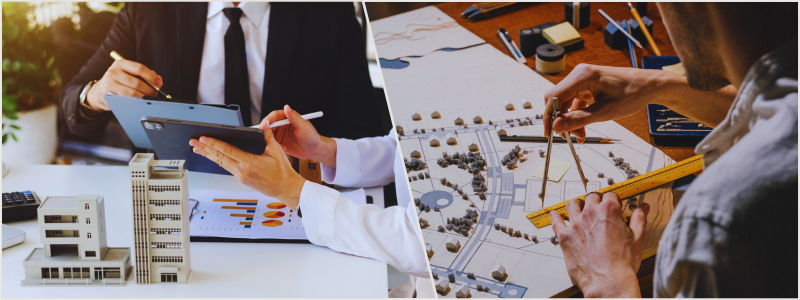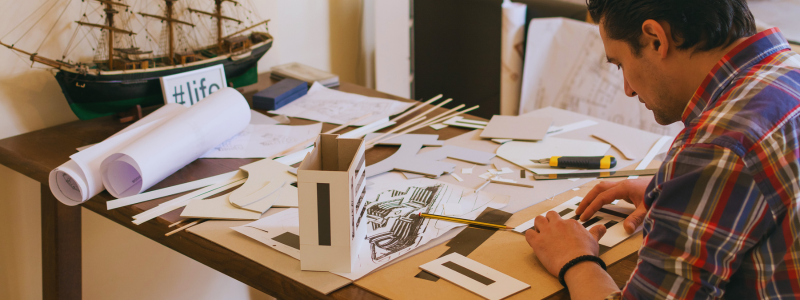Professional architects, architecture students, and hobbyists alike are all aware of the importance of architectural models to visualize designs and communicate these with other people. Architectural models are also used to experiment with multiple design ideas. They even aid with the planning and construction stages of architectural projects. This article features 3D modeling services and is a comprehensive guide to architectural model making for companies and firms to give you a better idea of the important role they play in the world of architecture.

What are architectural models?
Architectural models are physical representations of architectural designs or ideas. An architectural model can either focus on a particular element, like a key space, or element in architecture, or on an entire design to showcase a proposal in its site context. Architectural models exist at different scales, with the model’s purpose usually determining the suitable scale. A context model, for instance, is often on a smaller scale since its purpose is to present the proposal in block form with its context and with the minimum detail required.
On the other hand, a detailed model of a complex façade will require a bigger scale to highlight the build-up of all the architectural materials and elements that produce a better architectural feature. Architectural models are traditionally made by hand with the use of materials including foam board, card, hardwood or balsa wood, plaster, and Perspex while utilizing power tools as well. Today’s state-of-the-art technology allows the use of laser cutters, CNC machines, and 3D printers to speed up the process of making models and produce models that are also more accurate.
RELATED: How do architectural modeling services craft 3D house models for real estate?
Architectural models serve as visual aids throughout the design process. They are also used for presentation purposes during the final proposal. The model making’s physical act allows architects to understand their designs on a deeper level. Architects also get to explore the different physical qualities of the scale, form, and spaces they are making in a more tactile way. The models are also effective ways of representing the final proposal, with the stakeholders understanding the spatial relationships and architectural qualities of a proposal more easily through studying a miniature replica in 3D.
Why is the architectural model important for companies and firms?
It is very common to see architects examining architectural models at eye levels because this helps them imagine the design on a 1:1 scale. It doesn’t matter if you intend to make a presentation model or a conceptual model, it is important to have the ability to conjure the design at a 1:1 scale. An architectural model is a powerful tool for architectural design as it lets you explore the designs in a physical form.
Common uses and applications of architectural models
Architectural model making is used for several purposes and applications, such as the following:
Communication
3D Architectural modeling services facilitate and promotes communication among clients, contractors, and architects. At the same time, these models also help in conveying the intent of the design more effectively.
RELATED: How parametric design in CAD is transforming architectural modeling design practices
Evaluation
Architectural model making also gives architects the chance to evaluate the design proposal, pinpoint possible flaws, and improve the design throughout the development phase.
Presentation
Architectural models also improve the presentation of the final design by offering a more tangible physical focal point to entice viewers.
Visualization
An architectural model is a 3D representation of the designs to allow architects and the rest of the stakeholders to gain a better understanding of the spatial relationships, materiality, scale, and form of the proposal.

Types of architectural models
Architectural models come in different types, and these include the following:
Conceptual models
Conceptual architectural models are informal and fast. They help architects investigate and look into different holistic architectural ideas. These models are often made using low-budget materials with only primary tools required. A conceptual model often focuses more on simple forms with minimal detail.
RELATED: How 3D modeling has impacted the architecture and design industry throughout the last 30 years
Presentation models
Presentation of architectural models is effective in demonstrating final design proposals. These are usually for presentation and display to sell off the scheme to the rest of the stakeholders. Thus, these models are made by architectural presentation designers using quality materials in great detail.
Working models
Architects come up with working models to help them make informed design decisions throughout the design development phase. These are ready and rough exercises for experimenting in 3D form, scale, and spatial relationships. Mount board or cardboard are some of the common materials used for working models because these are easy to work with, not to mention low-cost as well.
Best tools for architectural model making
A crafter will never be able to craft with no tools to help him out. You will need a reliable set of tools that can get the job done to achieve the best results as far as architectural model-making is concerned. The good news is that there are now many companies out there that provide top-of-the-line tools that crafters can use. The best 3D model experts have an arsenal of excellent tools to produce scale models, especially if the models are made using wire or metal structures.
RELATED: Leading home design & modeling 3D technology for builders, companies, and firms
Craft knife
Sharp craft knives are essential to cut out shapes from the model materials.
Cutting mat
Cutting mats protect the work surface from cuts and scratches.
Glue
You can find a wide variety of glues in the market right now so make sure you choose the one that best suits the specific materials you are using or planning to use.
Paint
You can use paint to add more details and color to the architectural model.
Ruler
Rulers are important for accurate cutting and measuring.
Other tools
You might also require other tools as part of your architectural model making tool kit, depending on the specific type of model you’re making. These may include soldering iron, laser cutter, and hot wire cutter.
RELATED: How 3D modeling, rendering, and CAD design helps architects create sustainable construction
The architectural model making process
Now that you know the basics of architectural model making, it’s time to learn the steps involved in the process.
1. Conceptualize and plan
You have to decide on the purpose of your architectural model before you start building it. You will be able to determine it depending on what stage you are in the design process.

2. Collect reference materials
Research and gather architectural photographs, drawings, and examples of other similar architectural models that you can use as reference materials. These references can give you clearer objectives.
3. Identify measurements and scale
The purpose of the architectural model will dictate the suitable scale for it. A massing model, for example, would be a much smaller scale, like 1:200. This is because it is an exercise in spatial form and relationships. Meanwhile, a section model is on a larger scale like 1:25 because it requires a bigger level of detail.
RELATED: Exploring pricing models for delivering 3D architectural rendering services to firms
4. Form the base
Start by forming the base of the architectural model. See to it that you have an accurate representation of the topography and landscaping of the site. Your chosen materials should also be supportive enough as the foundation that you will build upon. Corrugated cards and foam boards are preferred here because of their cheaper price.
5. Build the structure
The type of architectural model you are making and the specific scale will determine the level of structure or detail required. A series of several smaller test models can serve as your guide in deciding on the modeling techniques and materials to use.
6. Add details
Adding fine details like textures, windows, and doors can improve the realism of an architectural model. This kind of detail is often more accurately and effectively modeled with the use of a laser cutter.
7. Consider the surroundings and landscape
Search for creative ways of representing your architectural model’s surrounding environment. Try making the trees by yourself using different materials because the worst thing you can do is buy artificial grass and model trees. Doing this will only make your landscape look similar to a train set.
RELATED: Learn about architectural design fee schedules, rates, and pricing for architect firms’ costs
8. Presentation and lighting
Consider adding subtle elements of lighting to improve the overall impact of the architectural model. You can light up certain interiors or areas through the installation of small LED lights.
9. Photography and documentation
Capturing your architectural model in high-quality photos is one of the most valuable ways to document your entire design process as well as the final design in your presentation and portfolio references.
Wrapping It Up
Architectural model making is an excellent way to envision your design concepts, communicate these to the stakeholders, and learn more about the construction phase. But of course, many also find this a rewarding and fun hobby to have.
During architectural model making, it’s recommended to use a scale and a cutting mat. See to it that the tools are also sharp. Use only the highest quality tools for architectural model making to guarantee a hassle-free and stress-free process.
How Cad Crowd can help
Cad Crowd can connect you with the best architectural model making services that can help your company or firm bring your concepts and ideas to life.
